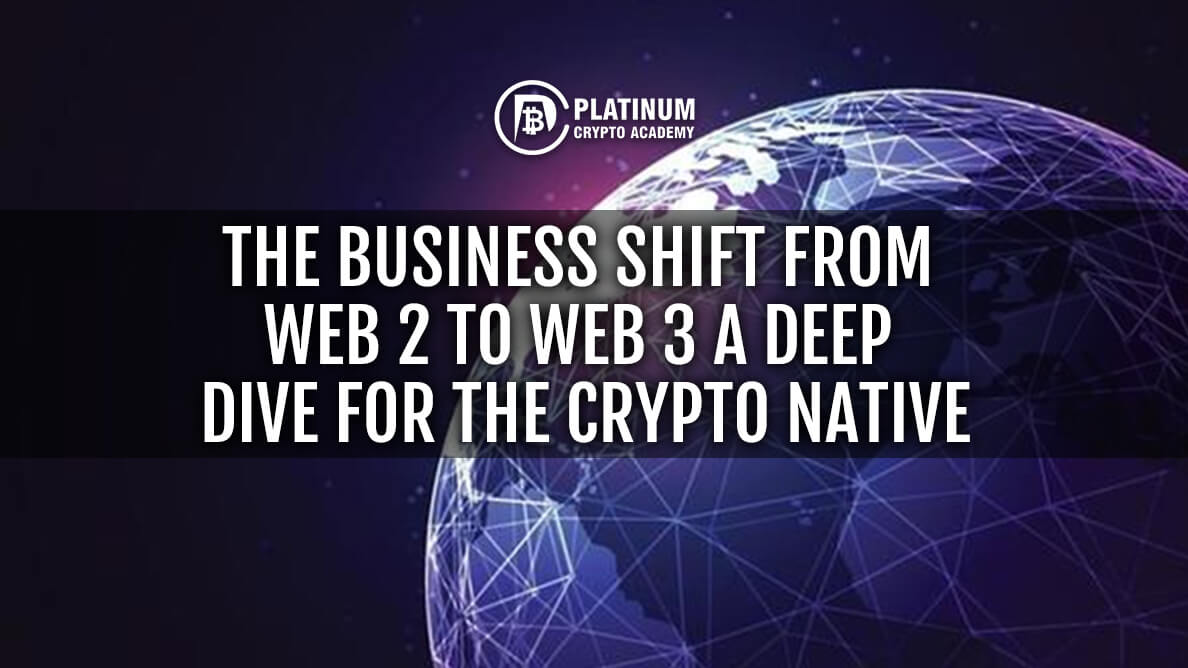Quick Links
In the landscape of technology, certain moments stand out as pivotal turning points. We are currently amid one such monumental transition. The digital realm, which has been our playground, marketplace, and community space, is undergoing a seismic shift, one that promises to redefine our online experiences and interactions. This profound transformation is the migration from Web 2 to Web 3. For the uninitiated, this might sound like a mere technical upgrade, akin to updating a software version. But it’s akin to the tectonic movements that reshape continents. We’re not just talking about faster load times or sleeker interfaces; we’re discussing a fundamental change in how the internet operates, how businesses function online, and how users interact with the digital world.
For those deeply entrenched in the crypto space, Web 3 is more than a term thrown around in tech conferences or boardroom meetings. It’s a vision of the future—a decentralized, transparent, and user-empowered digital universe. It’s a promise of an internet where users regain control, where intermediaries no longer hold disproportionate power, and where trust is built into the very code of the platforms we use.
But what does this mean for businesses, especially those that have thrived in the Web 2 era? How does this shift impact company owners who must navigate these uncharted waters, balancing the challenges of the new with the lessons of the old? Let’s delve deeper into this evolution, exploring the nuances, challenges, and opportunities it presents, especially from the vantage point of a company owner.

Web 2: The Centralized Era
The dawn of Web 2 marked a significant departure from the static, one-dimensional pages of Web 1. It was a time of innovation, collaboration, and rapid expansion. The internet transformed from a mere information repository to a dynamic, interactive platform, giving birth to what we now recognize as the social web.
- User-Generated Content: One of the hallmarks of Web 2 was the rise of user-generated content. Platforms like Facebook, Twitter, and YouTube empowered users to create, share, and interact with content. No longer were users’ mere consumers; they became active participants, shaping the digital narrative.
- The Rise of Tech Giants: As the internet became more interactive, certain platforms began to dominate the landscape. Companies like Google, Apple, and Amazon became household names, not just for their innovative products but for their ability to aggregate vast amounts of user data. These tech giants controlled the platforms, the algorithms, and, by extension, the user experience.
- Centralization of Data: With the growth of these platforms came the centralization of data. User information, preferences, behaviours, and interactions were stored in massive data centres, controlled by a few corporations. This centralization offered benefits, such as personalized user experiences and targeted advertising. However, it also raised concerns about data privacy, security, and monopolistic control.
- Business Model Dependency: For businesses, Web 2 presented both opportunities and challenges. The ability to reach a global audience, engage with customers in real-time, and harness the power of data analytics was transformative. Yet, there was a catch. Many businesses became heavily dependent on these centralized platforms for visibility and customer acquisition. Changes in platform algorithms or policies could drastically impact a company’s online presence and revenue.
- The Double-Edged Sword of Interactivity: While Web 2’s interactivity fostered community and collaboration; it also had its pitfalls. The spread of misinformation, cyberbullying, and the challenges of content moderation became pressing concerns. The very platforms that enabled global connection also became arenas for division and discord.
Web 3: The Decentralized Future
As the limitations and challenges of the Web 2 era became increasingly evident, the vision for a new kind of internet began to take shape. Web 3, often termed the decentralized web, promises a future where power, control, and data are distributed more equitably among users and entities. It’s a reimagining of the digital landscape, built on the principles of transparency, autonomy, and user empowerment.
- Blockchain and Cryptography: At the heart of Web 3 lies blockchain technology, a decentralized ledger system that ensures transparency and security through advanced cryptography. Unlike the centralized databases of Web 2, blockchain operates across a distributed network of computers, making data tampering nearly impossible.
- Decentralized Applications (dApps): Web 3 introduces the concept of dApps, applications that run on a peer-to-peer network, rather than centralized servers. These dApps are not controlled by any single entity, ensuring that they remain resistant to censorship and external control.
- User Sovereignty: One of the most transformative aspects of Web 3 is the emphasis on user sovereignty. In this new era, users have true ownership of their data. They decide who can access it, how it’s used, and can even monetize it if they choose. This shift promises to redefine the dynamics of the digital economy, placing value and control back into the hands of individual users.
- Tokenization and Digital Assets: Web 3 brings forth the concept of tokenization, where assets (be it digital art, real estate, or even one’s online identity) can be represented as tokens on a blockchain. This has given rise to phenomena like NFTs (Non-Fungible Tokens), allowing for unique digital assets to be traded and owned in a decentralized manner.
- Interoperability: Unlike the siloed ecosystems of Web 2 platforms, Web 3 emphasizes interoperability. Different applications, platforms, and systems are designed to work seamlessly together, ensuring a more cohesive and integrated user experience.
- Decentralized Finance (DeFi): The financial sector is undergoing a revolution with the advent of DeFi. Bypassing traditional intermediaries like banks, DeFi platforms offer financial services, from loans to asset trading, directly on the blockchain. This democratizes access to financial tools and services, especially for those previously underserved by the traditional banking system.
- Challenges and the Road Ahead: While Web 3 promises a more decentralized and equitable digital future, it’s not without its challenges. Issues like scalability, energy consumption of blockchain networks, and the need for user education are hurdles that the community is actively working to overcome.
Why This Shift is Crucial for Businesses
- User Data Control: Web 3 allows users to own their data. For businesses, this means gaining trust is paramount. No more data breaches or privacy concerns; just transparent operations.
- Decentralized Business Models: Companies can leverage decentralized finance (DeFi) protocols, tokenize assets, and even form Decentralized Autonomous Organizations (DAOs). This not only reduces operational costs but also democratizes business decisions.
- Enhanced User Experience: With technologies like the Semantic Web, businesses can offer personalized experiences, understanding user preferences at a granular level.
- New Revenue Streams: The rise of NFTs and virtual goods opens up avenues previously unimagined. Imagine selling virtual real estate or tokenized assets, creating passive income streams.
A First-Person Perspective: Web 2 Company vs. Web 3 Company – The Emotional Odyssey
The transition from Web 2 to Web 3 wasn’t just a business decision; it was an emotional journey. As I navigated the decentralized waters of Web 3, my friend Alex remained anchored in the familiar shores of Web 2. Our contrasting paths led to distinct emotional experiences, deeply intertwined with our businesses and personal lives.
The Initial Leap: Fear vs. Comfort
My Web 3 Company:
Anxiety and Uncertainty: Venturing into the unknown world of Web 3 was nerve-wracking. The fear of making a costly mistake or being too early in the game often kept me awake at night. I felt like I was walking a tightrope without a safety net.
Excitement: Amidst the anxiety, there was undeniable excitement. Every small win, be it a successful dApp launch or positive user feedback, felt like a massive victory. It was the thrill of pioneering, of being on the cutting edge.
Alex’s Web 2 Company:
Comfort and Complacency: Alex enjoyed the comfort of the known. His routines were set, and there was a predictable rhythm to his business. However, this comfort sometimes bordered on complacency. He felt safe, but there was an underlying fear of becoming obsolete.
The Midway Struggles: Growth Pains vs. External Pressures
My Web 3 Company:
Overwhelm: As the business started to grow, the challenges multiplied. Managing a decentralized community, understanding the ever-evolving crypto regulations, and staying updated with the rapid technological advancements was overwhelming. I felt stretched thin, juggling multiple roles.
Validation: Every time a competitor praised our innovative approach, or we were featured in a leading crypto publication, it felt like validation. It was a reassurance that the path, though challenging, was worth it.
Alex’s Web 2 Company:
Frustration: Alex often vented about his frustrations. The increasing costs of advertising, the constant need to appease the algorithms of tech giants, and the looming threat of data breaches weighed on him. He felt trapped in a system where he had little control.
Envy: Seeing our Web 3 company gain traction and recognition; Alex couldn’t help but feel a tinge of envy. He began questioning his decision to stay in Web 2, leading to moments of self-doubt.
The Long-Term Realizations: Fulfilment vs. Regret
My Web 3 Company:
Empowerment: The decentralized ethos of Web 3 seeped into our company culture. Empowering users gave me a profound sense of purpose. It wasn’t just about profits; it was about creating a fair, transparent digital world. This sense of purpose spilled over into my personal life, making me more confident and assertive in my decisions.
Community Bond: The bond I formed with our user community was unlike any other. They weren’t just customers; they were partners in our journey. Their success stories, their feedback, their trust became the emotional fuel that kept me going during tough times.
Alex’s Web 2 Company:
Regret and Reflection: As the digital landscape evolved, Alex felt left behind. He regretted not taking the leap into Web 3 earlier. This regret wasn’t just professional; it was deeply personal. He felt he had missed out on a transformative journey, both for his business and himself.
Yearning for Change: The emotional toll of staying in Web 2 started affecting Alex’s personal life. He became more restless, yearning for change, seeking the sense of purpose and community that Web 3 offered.
In the end, our contrasting paths were more than just business decisions. They were emotional odysseys, shaping our identities, our relationships, and our worldviews. The decentralized promise of Web 3 isn’t just about technology; it’s about a deeper, more profound connection to the digital realm and its inhabitants.
Web 3’s Value Proposition for Investors and Traders
For the crypto investors and traders reading this on our academy website or investment report, the shift to Web 3 isn’t just about technology; it’s about potential ROI. Companies transitioning to Web 3 are poised for massive growth. Investing in such businesses or trading their tokens could yield significant returns, given the early-stage nature of this shift.
Conclusion
The shift from Web 2 to Web 3 is parallel to the .com bubble. Just as having a website then was crucial, transitioning to Web 3 is now imperative. For businesses, it’s not just about staying relevant but about unlocking unprecedented value. For the crypto native, it’s an opportunity to be at the forefront of the next digital revolution.
Hopefully, you have enjoyed today’s article. Thanks for reading! Have a fantastic day! Live from the Platinum Crypto Trading Floor.
Earnings Disclaimer: The information you’ll find in this article is for educational purpose only. We make no promise or guarantee of income or earnings. You have to do some work, use your best judgement and perform due diligence before using the information in this article. Your success is still up to you. Nothing in this article is intended to be professional, legal, financial and/or accounting advice. Always seek competent advice from professionals in these matters. If you break the city or other local laws, we will not be held liable for any damages you incur.


